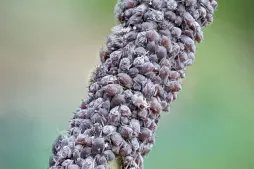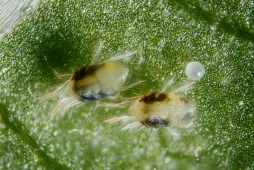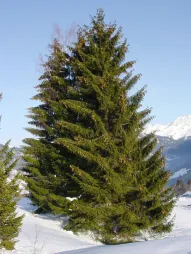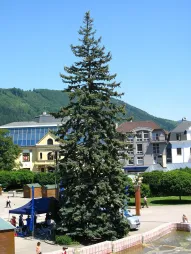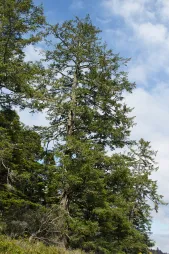Picea omorika, Serbian spruce
You've never heard of the Serbian spruce (Picea omorika in Latin)? No wonder. Even in the Balkans, where it's endemic, this tree of the Pinaceae family remains fairly rare. However, you may also come across its slender silhouette at the bend in a road or garden elsewhere in Europe.
How to recognize Picea omorika, the Serbian spruce?
Picea omorika is an upright, narrow tree. It grows to a height of 35 metres, with a spread of only three to five metres.
Its one-meter-diameter trunk bears hanging branches with upturned tips, andthe wood is covered with brown, scaly bark.
The Serbian spruce has evergreen foliage. Its flattened, blue-green needles have a darker upper surface. The underside is also illuminated by white stomata.
With their broad base, the spindle-shaped cones look almost like spinning tops. Initially dark purple, they turn brown when mature, as in picea mariana.
Picea omorika is not toxic on contact or ingestion. You can grow it without fear, even if you share your garden with young children or curious animals.
Our maintenance tips
Consider the growth of your Picea omorika before planting it. The largest specimens exceed several dozen meters in height and should therefore be installed where they won't get in anyone's way.
Watering
Picea omorika likes regular, but not excessive, watering. Its roots must not be drowned. Use non-calcareous water, such as rainwater or filtered water at room temperature.
Between waterings, let the soil dry on the surface (by about two centimetres).
Remember to remove any stagnant water from the saucer or planter.
Repotting
Choose a pierced terracotta pot. This material ensures more uniform evaporation of water and prevents root rot. The container should be deep so as not to topple under the weight of the plant and allow your Picea omorika to grow. Gravel or clay balls can be placed at the bottom to improve drainage.
Pour in a layer of rich potting soil, such as potting soil for acid-loving plants. Plant your Picea omorika. The root ball should be three to five centimetres below the edge to form a watering trough. Add potting soil.
Press down and water until the water runs off through the drainage holes to encourage rooting.
Fertilization
To promote the growth of your Picea omorika, apply fertilizer in spring and summer.
Fertilize your Picea omorika with a conifer fertilizer once a month. Follow the dosage and manufacturer's instructions to avoid damaging the foliage.
Prune
Your Picea omorika does not need pruning. On the contrary, pruning could be detrimental to its growth.
You can, however, remove dead branches in early summer using a clean, sharp tool, such as pruning shears.
Plantation
Soak your Picea omorika to rehydrate the root ball.
Meanwhile, dig a hole twice the size of the root ball. Plant your Picea omorika. The rootball should be level with the soil. Fill in with a mixture of garden soil and universal potting compost. You can add fertilizer if your soil is poor.
Press down and water thoroughly to help the plant take root.
Seedling
Your seeds are more likely to germinate if you stratify them cold.
Fill an airtight bag (e.g. A freezer bag) with potting soil for seedlings and plantations. Moisten the substrate. Bury your seeds in the potting soil, close the bag and place it in a place where the temperature is between 0 and 5°C for three weeks (refrigerator, garage).
Check your seeds regularly to make sure the potting soil stays moist and doesn't rot. As soon as a seed germinates, you can plant it.
Pour seedling and planting soil into cups. Plant your seed a centimetre deep. Spray the substrate to moisten it.
Place your seedlings in a bright spot where the temperature does not exceed 15°C.
Diseases / Threats
Information
| Family | Pinaceae - Pinaceae |
| Type | Picea - Picea |
| Species | Picea omorika - Picea omorika |
| Lifecycle | Perennial |
| Foliage | Evergreen |
| Exposure | |
| Substrats | |
| Planting methods |
Open ground In pots In tubs |
| Category | |
| Tags |
Beginner Rustic |
| Origin |
Eastern Europe |
| Hardiness (USDA) | 6a |
| Leaf color |
|
| Flower color |
|
| Fruit color |
|
Discover plants from the same family













